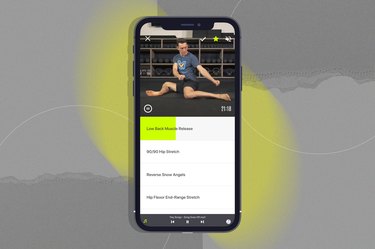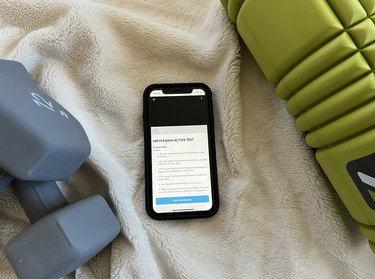
I've always been an avid runner, but recently I've had to pull out of a few races. Back in June, I was plagued by tight hips and unbearable lower back pain, resulting in months of physical therapy. And honestly, I'll be the first to admit I don't properly warm up or pay much attention to my mobility.
I'm recovering now and able to run (mostly) pain-free again, but I'm much more conscious of how I prep for my workouts. And while I was given a few exercises to do at home by my physical therapist, it wasn't always the easiest to find motivation to complete moves on a printed-off sheet of paper with little guidance.
Video of the Day
Video of the Day
I wanted to continue my progress even after "graduating" from my twice-weekly PT appointments, but wasn't sure I could keep doing the same handful of exercises without getting bored.
Enter: Movement Vault, a comprehensive flexibility and mobility program and app designed to help improve your range of motion to support your movement for both training and life.
Warning
If you're recovering from an injury or are experiencing pain, be sure to talk with your doctor before starting a new exercise routine.
How Does the App Work?
First, it's suggested you get started with a 14-move mobility assessment. You'll be assigned a total mobility score along with an individual mobility score for each major area of your body. You can use these scores to help you figure out what joints and areas of your body are tight and focus on improving your mobility in these areas.
From there, you can choose from a wide array of classes and mobility exercises — new videos are posted daily, which include standard daily classes, recovery workouts and more. (It's worth noting there's a free version of the app and a premium version, and the premium version offers a larger variety of workouts than the free version. You can also download the workouts for offline use with the premium version.)
Additionally, the app offers a custom routine builder, where you can create your own perfect routine based on time, areas of your body you want to focus on and the equipment you have available.
The app also contains pain and injury programs, which are multi-week programs focused on alleviating pain or rehabbing an injury in a specific body part, such as your lower back.
"My goal is to really change the way joint health and body maintenance is looked at," says the app's founder Grayson Wickham, DPT, CSCS. "I want to change the way people think about their body and get them to see the value of proactively working their joint health and mobility."
Regardless of if you use the app three times per week or every day, it's designed to help you find a dynamic stretching program to help you improve your joint health and mobility. You can use Movement Vault in tandem with your typical workout routine.
What Are the Classes Like?
Because everyone has different goals they're training for and experience pain or lack of mobility in different areas, no two experiences will be totally alike.
Wickham notes that after working with hundreds of people, there are many similar patterns that lead to pain or lack of mobility, which is why this program is able to translate across all abilities and fitness levels.
To help you choose a class or program, you can first see a full description of what the workout entails, including what body parts you'll be focusing on, what exercises the movements will help you prep for, the modalities you'll be completing, the muscles you'll activate, the equipment needed and an overall preview of the class. Once you hit "start class," you'll still be able to see this info.
An instructor will talk you through each move of the workout, then do each move with you — demonstrating proper form and offering modifications that can help you make the move more difficult.
I primarily picked classes with a focus on hips, lower back and core, but also added a couple of varied mobility flows throughout the week. It looked a little something like this:
- Sunday: Flow (full-body mobility)
- Monday: Lower Body, Back and Core
- Tuesday: Custom Routine (pre-run warm-up)
- Wednesday: Hips and Core
- Thursday: Custom Routine (pre-run warm-up)
- Friday: Rest Day
- Saturday: Ankles, Hips and Core
I built a 10-minute custom routine to use as a pre-run warm-up, again to focus on my hip mobility. Take it from me, runners, you need to be doing a dynamic warm-up to prep for your run in order to stay injury-free.
What's cool about this app is even when you build a routine, you are able to see the difficulty level, equipment needed and the benefits of each move like you would in the pre-programmed classes.
To keep you accountable, in your profile, you can track your stats, including the number of sessions you've completed, your total mobility time, the average duration of your workouts and your longest streak. As you progress, you can retake the mobility assessment to help track your progress.

What I Liked About It
- You can use Movement Vault's filtering system to quickly locate the perfect stretching and mobility routine for you. Unsurprisingly, I gravitated toward classes that focused on the hips, lower back and core, thanks to my experience in physical therapy and my mobility assessment results.
- You can favorite classes you like so you can easily return to them without searching the app.
- The app helped me establish a routine. Coming off of working with a PT two days week for an injury, this app helped keep me accountable to continue daily dynamic stretching and mobility work.
- Aside from the mobility routines, the app offers exercises that focus on one part of the body, pre-workout warm-ups, recovery stretches (which is more of a focus on static stretching and foam rolling) and workouts that can be done anywhere.
Potential Drawbacks
- The app is currently only available for iOS, but Android support is in the works. (In the meantime, there is a web version that will allow you to use Movement Vault on Android, tablets, etc.)
- While the free version of Movement Vault offers you access to the app, you'll only be able to access a select amount of workouts for free. Upgrading to Premium Movement Vault is $14.99/month or $119 per year, which may be cost-prohibitive for some.
- While the app offers pretty comprehensive explanations and demos of each move, without someone watching you and providing feedback, there is potential to do the moves incorrectly.
- Those who demo the moves on screen are not size-inclusive.
Should You Try It?
Movement Vault contains comprehensive programs that are put together using science and research-backed techniques, alongside Wickham's years of experience treating patients. This sets the app apart from just pulling up stretching or mobility videos on YouTube.
Additionally, every technique is vetted by professionals like Wickham, and the workouts are designed in a specific order to ensure you get the best bang for your buck.
Athletes often think they are getting enough exercise through their training, but forget crucial steps like a proper warm-up or to mix up their workouts, which is where Movement Vault comes in.
For example, runners may be getting plenty of movement throughout the day, but running is performed in one plane of motion. It's important to vary your movements and make sure your muscles have proper range of motion. If they don't, other muscles may be compensating to complete the movement, which can lead to injury over time.
If you're not an avid exerciser and are more interested in just living life with fewer aches and pains, you'll be able to find a program for you that will help you become more proactive with stretching and mobility.
"Our body conforms to the positions we spend the most time in," Wickham says. "For most people, this is sitting down, which leads to tight muscles and joints."
The great thing about this app is there are many exercises you can do with no equipment and require little time. For example, there are short routines you can do from your chair while you're working from home to help reduce the strain on your body and correct your posture. Again, it's not just for athletes.
Begin Your Mobility Journey With Movement Vault
Download it: iOS; Price: Free for basic membership; $14.99 per month for premium membership